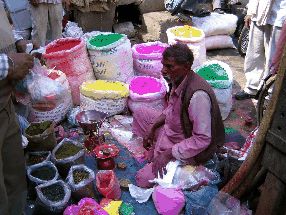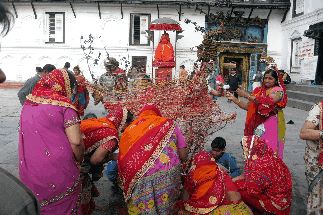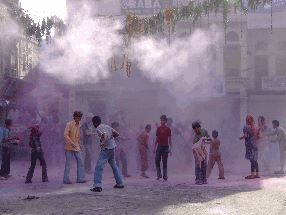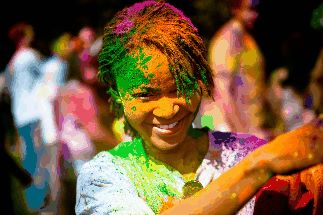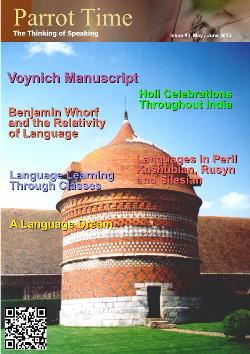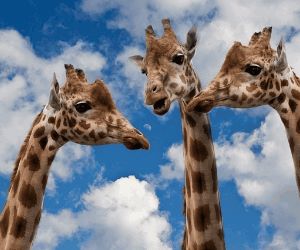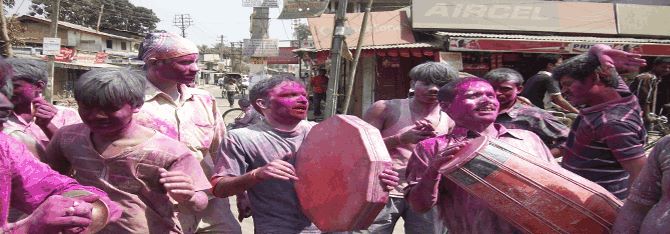
|
Celebration The way Holi is celebrated, as well as the duration, varies by region all over India. A primary part of it is the lighting of bonfires the night before the festival, which is always on a full moon, on many street corners. This is often called Holi Paurnima ("Holi Full Moon") and is done as a celebration of the burning of Holika as well as a means of cleansing the air of evil spirits. The next day, all shops and offices are closed. Everyone comes out of their homes and into the streets, dressed in white. During this time is the wild celebration as people run around throwing coloured powder and squirting coloured water at each other. Water balloons filled with coloured water may also be used. Some people form groups called tolis and move around more slowly, spreading colours and greeting others. There is also singing and dancing among the activities and eating of many sweet foods. This goes on for a few hours before everyone finally goes to the river or baths to wash themselves before relaxing for the afternoon. In most areas, Holi lasts about two days. 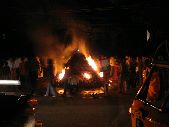 Bonfire on Holi Dahan Many regions bring in their own ways of celebrating, extending the holiday, and even giving it other names. In Gujurat, for example another tradition is to hang a pot of buttermilk high above the street. Young boys form human pyramids in attempts to reach and break it while girls try to stop them by throwing coloured water at them. The young boy that manages to break the pot is crowned the "Holi King". In some places, the women of the family will beat their brother-in-laws with their rolled up saris in mock anger while the brother-in-laws try to drench them with coloured water. In the evening, the brother-in-laws will bring them various treats. 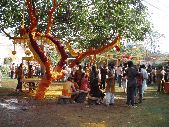 Holi party in Delhi, with crowd and a tree decorated in coloured fabrics The region of Uttar Pradesh has a number of variants. In Barsana, they have the "Lath mar Holi" ("that Holi in which people hit with sticks") before the regular Holi. For this, women chase away men and beat them with sticks while others watch, singing songs. Kanpur extends Holi to seven days and is followed by a large fair called "Ganga Mela" to celebrate the freeing of Kanpur from British rule after the First Indian War of Independence in 1857. People from all castes, creeds, religion and societies join in. The Ganga Mela, which takes place a few days after Holi, marks an end to it with the washing in the river. On the eve of Ganga Mela, all government offices and shops remain closed so major business groups and politicians gather along the Ghats (steps that lead down to the water) of the River Ganga banks. The next few days are full of remembrance and worship along with various fun contests and selling of toys and other items at fair stalls. The Kumaon region of Uttarakhand has a very unique form of Holi. Much of the celebration involves a great deal of singing songs based on classical ragas (melodic modes used in Indian classical music). The singers usually wear traditional white churidar pyjama and kurta while dancing in groups. 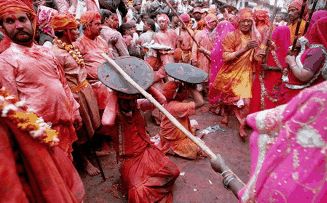 Braj Lath mar Holi in Barasana, India In Bengal and Orissa, Holi is called Dol Purnima ("Swing Festival") and is dedicated more to Lord Krishna and Radha. On the Dol Purnima day in the early morning, the students dress up in the early morning in saffron-coloured or pure white clothes, wearing garlands of flowers, and sing and dance to the accompaniment of traditional musical instruments like the ektara and veena. Icons of Krishna and Radha are places on a richly decorated swinging palanquin and taken round the main streets of the city. Women dance around the swing and sing devotional songs while men keep spraying them with coloured water and powder. In Orissa, however, icons of Jagannath, the deity of the Jagannath Temple of Puri, replace the icons of Krishna and Radha. While Dol Purnima focuses more on the Krishna legend, Holi in Maharashtra is mainly associated with the burning of Holika. There, Holi Paurnima is also called as Shimga. A week before the festival, children go around the community, collecting firewood and money. The firewood is arranged in a large pile at on the day of Holi and is lit that evening. Each household then makes an offering of a meal and dessert to the fire god. Shimga is about the elimination of all evil. Unlike the Holi festivals of the north, the colour celebrations here normally take place on the day of Rangapanchami, which is five days after Holi. The festival is supposed to help people forget about rivalries and to start new, healthy relations with others. 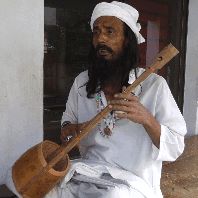 Man playing an Ektara In Manipur, Holi is celebrated for six days and is merged with the centuries-old festival of Yaosang. The festival starts with the burning of a thatched hut of hay and twigs while young children go around to the houses collecting money, known as nakadeng (or nakatheng), as gifts on the first two days. At night, youths perform a group folk dance, the Thabal Chongba, on the full moon night along with folk songs and rhythmic beats. Similar performances are done in the Krishna temples, in which devotees sing devotional songs and perform dances while wearing traditional white and yellow turbans. No matter what it's called or how it's celebrated, Holi is mainly a celebration of renewal. It is the time to start the new year, drive away bad feelings, and to celebrate with everyone around you. Formalities and inhibitions are dropped and a spirit of joy and love is spread throughout the community. The Festival of colour is truly a wonderful tradition for the entire country. | ||||||||||||||||||||||||||||
|
Vocabulary
| ||||||||||||||||||||||||||||
| ||||||||||||||||||||||||||||
| Celebrations - Holi | ||||||||||||||||
| Writer: | Sonja Krüger | |||||||||||||||
| Images: | ||||||||||||||||
| ||||||||||||||||
| Sources: | ||||||||||||||||
| ||||||||||||||||
All images are Copyright - CC BY-SA (Creative Commons Share Alike) by their respective owners, except for Petey, which is Public Domain (PD) or unless otherwise noted.
comments powered by Disqus
